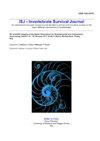比较蛋白质组学分析表明,幼体激素结合蛋白和腺苷酸激酶可能参与了家蚕的蜕皮过程。
IF 1.2
4区 农林科学
Q4 IMMUNOLOGY
引用次数: 3
摘要
蜕皮是家蚕变态发育的重要组成部分。虽然已有研究表明家蚕的蜕皮与促胸性激素(pth)、蜕皮激素(MH)和幼崽激素(JH)有关,但目前尚不清楚家蚕蜕皮过程中蛋白质和基因的变化及其产生和维持的分子机制。本文采用蛋白质组学方法对这一问题进行了研究。通过质谱分析和数据库检索,共鉴定出35种不同的蛋白,其中42%的蛋白与细胞结构有关,16%的蛋白属于代谢组。同时,液泡ATP合成酶、幼体激素结合蛋白前体和腺苷酸激酶同工酶在蜕皮早中期下调,定量实时聚合酶链反应(qRT-PCR)进一步证实了这一点。综上所述,我们的数据表明,幼体激素结合蛋白(JHBP)和腺苷酸激酶(AK)在家蚕的蜕皮过程中起着关键作用,可能参与了家蚕蜕皮的调控。本文章由计算机程序翻译,如有差异,请以英文原文为准。
Comparative proteomic analysis reveals that juvenile hormone binding protein and adenylate kinase may be involved in the molting process of silkworm, Bombyx mori.
The molting is an essential part of the silkworm metamorphosis development. Although previous studies have demonstrated that molting in silkworm is associated with prothoracicotropic hormone (PTTH), molting hormone (MH), and juvenile hormone (JH), the changes of proteins and genes during silkworm molting, as well as the molecular mechanism about its generating and maintaining remains unclear. In this paper, the proteomic approaches were employed to investigate this issue. Totally, 35 different proteins were successfully identified through mass spectrometry and database searches, among which 42 % proteins were involved in cell structure and 16 % proteins belonged to the metabolism group. Meanwhile, vacuolar ATP synthase, juvenile hormone binding protein precursor and adenylate kinase isoenzyme were found to be down-regulated at early, mid-molt stages, which were further confirmed by quantitative real-time polymerase chain reaction (qRT-PCR). Taken together, our data suggests that juvenile hormone binding protein (JHBP) and adenylate kinase (AK) play a critical role in the process of silkworm molting, which may participate in the regulation of silkworm molting.
求助全文
通过发布文献求助,成功后即可免费获取论文全文。
去求助
来源期刊

ISJ-Invertebrate Survival Journal
IMMUNOLOGY-ZOOLOGY
CiteScore
2.10
自引率
0.00%
发文量
0
审稿时长
>12 weeks
期刊介绍:
Invertebrate Survival Journal (ISJ) is an international and open access journal devoted to prompt and innovative studies on the basic defense mechanisms in invertebrates, in particular with a view to identifying biotechnologies able to act against derived diseases and related economic damage.
Contributions will be mainly in the form of Letters to the Editor, Visions and Perspectives, Short Communications, Technical Reports, Research Reports, Review, Minireview and Reports of Meetings. Letters to the Editor can be commentaries or perspectives on invertebrate defence mechanisms or replies to the data published in ISJ.
 求助内容:
求助内容: 应助结果提醒方式:
应助结果提醒方式:


